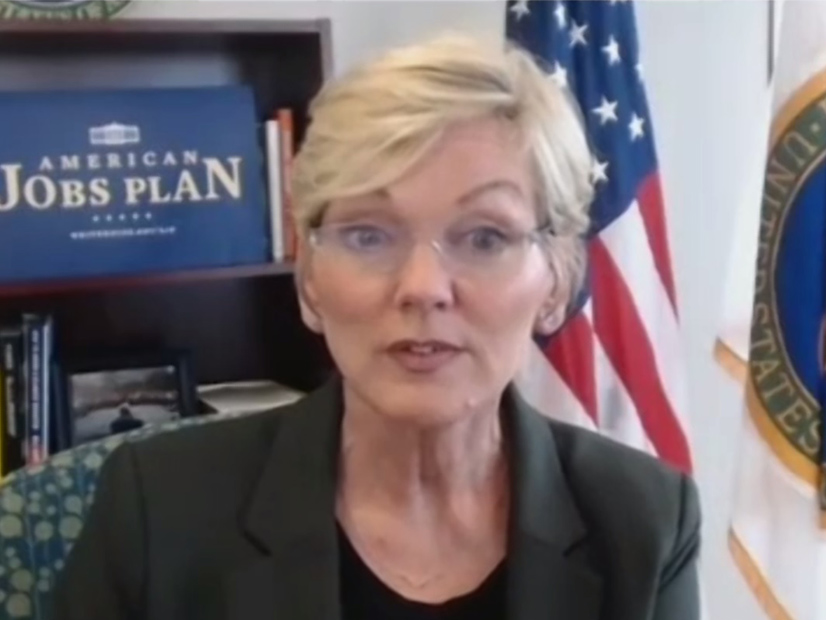Secretary Jennifer Granholm kicked off the Department of Energy’s 2021 Better Building and Better Plants Summit Monday with the announcement of a $12 million prize targeting lighting efficiency.
The “L-Prize,” Granholm said, will “spur transformative designs that can unlock” further energy savings from lighting, beyond the efficiencies of LED bulbs.
“Our goal is to manufacture these technologies here in America, and then to install them right away, delivering benefits to people even before the competition ends,” she said.
Granholm’s second announcement focused on the Better Buildings Low-Carbon Pilot, aimed at advancing innovative solutions for low- and no-carbon buildings across a range of building sectors. Recognizing that getting to zero carbon will require more than onsite renewable energy, the pilot has drawn in more than 55 partners nationwide, ranging from major corporations, such as Ford and General Motors, to the River Trails School District 26 in Mt. Prospect, Ill., which has three buildings for its 1,500 K-8 students.
“Together we’re going to figure out which strategies work, where folks are getting stuck, where we need to target our research and development priorities,” Granholm said. “And then, of course, in the full spirit of this initiative, we’re going to share what we learn with the rest of the market, so that they can chart their own courses.”
Granholm noted that in the 10 years since former President Barack Obama started Better Buildings, the program’s hundreds of partners had saved 2.2 quadrillion Btus of energy and $13 billion in energy costs, while keeping 130 million metric tons of greenhouse gas emissions out of the atmosphere.
“Those are actual, phenomenal, etched-in stone impacts, and they reach obviously far beyond your bottom lines,” Granholm said. “The cutting-edge technologies that you adopt become industry standards; the pilot programs that you illuminate [become] best practices, and that’s how progress gets made and policy gets adopted at the granular level.”
White House Roundtable
Granholm continued to focus on accelerating building decarbonization during a White House roundtable for the summit, saying DOE will launch a new initiative to spur heat pump adoption.
Under the Better Energy, Emissions and Equity (E3) initiative, DOE will work with deployment partners to bring heat pumps to homes and businesses. Because heat pumps work best in moderate climates, DOE will pair E3 with a cold climate technology challenge to spur R&D for cold-weather solutions.
New Energy Star standards will also boost heat pump technology for residential water heaters and heating and cooling equipment, according to U.S. Environmental Protection Agency Administrator Michael Regan, who joined the roundtable.
“These specifications, along with leveraging the Energy Star label and our extensive network of partners, will set the stage for providing every American household with access to clean, affordable heat and water heating, even when temperatures are very low,” Regan said.
If all central air conditioners and electric water heaters sold in the U.S. meet the new Energy Star specifications, he said, the cost savings will grow to $11 billion a year and it will avoid one-third of all direct GHG emissions from U.S. homes and apartments.
In addition, Regan said Energy Star is developing a new initiative to accelerate energy efficiency and electrification retrofits in existing homes.
The home upgrade program will focus on measures that offer the greatest potential to reduce fossil fuel use in homes.
“A key focus of this effort will be underserved households that suffer the highest energy burden,” he said. “We want to accelerate emerging business models that can deliver at a scale to these overburdened communities, such as … inclusive utility investment approaches with robust consumer protections like pay as you save programs.”
Granholm said DOE also plans to support deployment of efficient building technologies with a $30 million investment in workforce development.
“That money is going to go toward expanding our support for union, trade association and educational institutions and programs that are training American men and women for jobs in construction and retrofitting and code enforcement and more,” she said. “We’re going to grow a world-class domestic building workforce.”
Federal Building Standard
The U.S. General Services Administration will work with DOE, EPA and the White House Council on Environmental Quality (CEQ) to create buildings performance standards for properties owned and leased by the federal government.
GSA manages a federal real estate portfolio that includes close to 1,700 owned assets with about 186 million square feet, acting GSA Administrator Katy Kale said during the roundtable.
The performance standards will establish metrics, targets and tracking methods to reach federal carbon emission goals and identify progressive performance milestones, Kale said.
In addition, GSA, in collaboration with the National Renewable Energy Laboratory, is releasing a blueprint for integrating grid interactive, efficient technologies building retrofit projects to achieve federal energy savings.
“With our enormous building footprint, the federal government is in a unique place to lead by example,” Kale said.
To support the development of the building standard, CEQ will be launching a building stakeholder series.
“We need to hear from experts … and state and local governments who have already implemented successful policies,” CEQ Chair Brenda Mallory said during the roundtable. “We need to hear from communities so that our policies are creating real, tangible benefits for them.”



